Tag: Virginia Vineyards
If we’re winter pruning, then Spring must be close
Maintaining a vineyard is a year-round enterprise. Even in the winter, after the vines go into a dormant state, there’s work to be done. In fact, dormant winter pruning is among the most time-consuming work of the year, and some of the most important as well, since it involves decisions that will affect not just the coming season’s growth, but the year after as well.
Most of the objectives of dormant pruning fall under the heading of “balance.” Vines will grow just fine on their own, with no pruning at all, but most of their energy will go toward producing shoots and leaves, rather than grapes. Absent any intervention, the vines will continue to grow skyward for so long as they can find support. The whole purpose of a trellis system and the pruning decisions that go with it are to force the vine to direct its energy toward the production of high-quality fruit rather than vegetative growth.
So we’re looking for balance as we decide which shoots and how many buds to retain. Prune away too much and the vine will be undercropped, producing less fruit than it can reasonably support. Prune away too little and it will be overcropped, producing a profusion of leaves and shoots, as well as an abundance of fruit that is destined to be of low quality.
During the growing season, we’ll drop some fruit from the vine, again to direct energy toward the remaining clusters in the hopes of producing more concentrated and higher-quality grapes. But the first decisions we make that will determine the quantity and quality of the season’s fruit are those made in the dead of winter.
Which is to say, when it’s cold outside. Really, really cold. Not to mention snowing every few days or so. (Or maybe it just seemed that way this winter.) Which is one of the reasons we’ve put off pruning.
The other, more noble reason for delaying our pruning, has to do with timing. It’s better not to prune too early in the season – the untouched vines will survive a cold spell much better than those that have been pruned back, and by waiting, you’ll have more options in the case of a late freeze that damages buds and shoots.
It’s helpful to be able to assess the vine late in the winter for cold injury before deciding which canes to remove and which few to retain. In our little hobby vineyard, we have the luxury of delaying for almost as long as we want to start dormant pruning. Commercial vineyards that have acres of vines to prune, don’t have that luxury. They need to start early enough to be able to finish the job before budbreak. But many vineyards employ a technique of double pruning, going through once early in the winter to trim away the shoots they know won’t be used, and returning later to finish up the job.
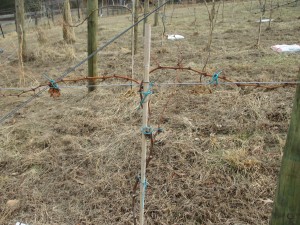
This cane-pruned vine is finished on the left arm, only partly done on the right. Click on the picture for a better view.
Our vines are all trained to a trellis system known as vertical shoot positioning, of VSP, and we have adopted a pruning method known as cane pruning. In cane pruning, most of the previous year’s growth is pruned away, and two one-year old shoots, which have now achieved the status of canes, are retained and trained in either direction along the bottom, or fruiting wire. These canes – the one-year old wood – will give rise to new shoots this summer, and these new shoots are the part of the vine that will bear fruit.
At the same time, we’ll be looking for renewal spurs below this year’s fruiting canes. These will be pruned back to one or two buds to provide the fruiting canes for the following year.
I’ve taken a class or two on pruning, and I’ve done lots of reading and studied more videos on the Internet than I can count. So, of course, I should be an expert. And in theory I am. I know a lot about the why’s and how’s of pruning. But the actual pruning – the time when you come face to face with a vine and decide what to lop off and what to keep – that’s a whole different story. I still remember my first pruning session. I was sure that I was going to destroy the vine, and I stared at it for what seemed like hours before I worked up the nerve to make that initial cut. I’ve gotten a little more confident, but only a little. I still spend way too much time on each vine. Fortunately, we only have 230 vines now, so I can get away with it.
When the Vineyard Goddess and I got out a few weeks ago – and yes, we chose a weekend when the temperatures were in the 60s – we realized that we had not maintained the vines as well as we should have in the previous year. No neglect, just the kinds of mistakes you make early on. A number of the vines were just fine, but others lacked the kind of year-old shoots we were looking for to train to the cordon wire.
So, we made some adjustments. On the vines that had perfect one-year old shoots, we cut away everything else and tied these canes down. On those that didn’t, we resorted to a different pruning method called spur or cordon pruning.
In spur pruning, a cordon is tied down to the wire and used year after year. The shoots from the previous year are pruned down to two buds, which will give rise to fruitful wood for the current season. It’s more like a haircut, and most people would say it’s a far easier method of pruning than cane pruning. And it works well for at least the first decade. At some point, however, these cordons grow thick from age and produce fewer spurs. Moreover, they’re more prone to disease. It’s the same with people. The older you get, the more opportunity your body has to develop diseases.
Which method is better? Well, they each have advantages and disadvantages. Jim Law, founder and owner of Linden Vineyards, said he started with spur pruning, which worked well for years, but eventually moved to cane pruning, after the disadvantages – disease in particular – began to outweigh the advantages.
Our thought, however, is that we’ll spur prunes those vines that need it this year, while leaving some buds that we hope will give rise to canes that can be trained to the wire in 2015. And while I remain hopeful that our vines will produce some wonderful fruit thisyear for making wine, I am confident that we’ll do even better next year and better still in each of the succeeding years. After all, this is a learning experience, and Lord knows, we’re learning.
A Tough Year for a Weekend Vintner
It was a tough year to be a weekend vintner.
When you’re separated from your vineyard by a two-hour drive, you have to make the most of your time. And we try. But the weekends are short, and there’s so much to do. And every curve that Mother Nature throws your way puts you just a little bit further behind. This year, Mother Nature was throwing curves, sliders, and the occasional spitball.
This year began with a late spring frost, followed by rain. Not just a little rain, but lots of rain, which gave rise to all kinds of fungal disease potential. Powdery Mildew, Downey Mildew, Botrytis, you name it.
And then came the pests: Japanese beetles, birds, raccoons, squirrels, deer, and even bears. Yes, indeed, bears. No lions or tigers,though. Just birds, deer and bears. And yeah, racooons and beetles and the rest of the pests.
That’s one of the reasons I’ve not been able to pay much attention to this blog. Another was that Chris and I took on responsibilities for editing Grape Press, the quarterly publication of the Virginia Vineyards Association. But mainly it was the challenges of the growing season. It seems like we spent all of our spare time each weekend keeping up with the vineyard. Spraying, cultivating, pruning, and spraying. Yeah, lots of spraying. It wasn’t easy.
Let’s start with the late frost. I remember arriving at the vineyard early one Saturday morning to find our whites all but devastated. Honestly, it looked as though someone had sprayed Round-Up and left them to die. For a while, I actually wondered if they had been the victims of spray drift from the herbicide we had used to clear a row for new the new vines we had planted this year.
Fortunately, that was not the case.
After checking the temperatures recorded nearby, I realized that we had probably experienced at least one and possibly two frost events in which temperatures had dropped just below freezing for a few hours in the early morning. My reds were fine, but they are planted higher on the slope and there’s a good possibility that temperatures stayed a degree or two higher in their part of the vineyard. Alternatively, bud break came earlier for the whites and they may have just been victims of bad timing. I’ll never know.
It turned out okay, though. Both the Petit Manseng and the Viognier had enough secondary buds left to generate growth for this year. Within a few weeks, we were seeing buds break and shoots begin to develop. And by the middle of the summer, they were looking like grape vines again. So, all was well.
But then it started to rain. Continue Reading–>
Just off the Grape Press: New Editors
It’s a pleasure to announce that the Vineyard Goddess and I are now co-editors of Grape Press, the quarterly publication of the Virginia Vineyards Association. Our first issue is the just-published Spring 2013 edition, and while we took over editorial responsibilities too late to have had any role in the planning, we spent lots of time collecting articles, working with the authors on final edits, revamping the look of page 1, and dealing with the hundreds (well, dozens and dozens) of little details that come up as you’re going to press.
We’re very excited about this opportunity for a number of reasons. First, lots of folks in the Virginia viticulture community have been 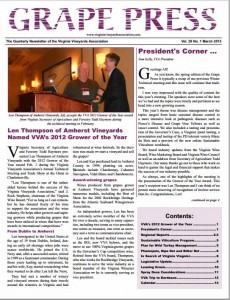 very generous with us, giving hours of their time to assist in our education. Early on, for example, I posted a note to a web site for the Central Virginia Winemakers group asking a question about how much time I should expect to set aside to manage a small vineyard I got lots of responses, and two of the folks who replied to my query hosted us at their vineyard for what amounted to a seminar on growing grapes.
very generous with us, giving hours of their time to assist in our education. Early on, for example, I posted a note to a web site for the Central Virginia Winemakers group asking a question about how much time I should expect to set aside to manage a small vineyard I got lots of responses, and two of the folks who replied to my query hosted us at their vineyard for what amounted to a seminar on growing grapes.
Secondly, we’re big fans of Virginia wine. We attended our first Virginia wine festival some 25 years ago, and while the wines weren’t great back then, some were pretty good, and we thought they all had promise. We were right. The wines got better each year, and today, we think Virginia wines have really come into their own. Virginia Viognier is a world-class wine. Cab Franc, Merlot, Petit Verdot, Petit Manseng, Norton and a number of other grape varieties have been made into truly great wines. My personal view is that a number of the Commonwealth’s wineries are making wines that can compete anywhere in the world, and their ranks are growing each year.
A major reason for the continued improvement in Virginia wine is the quality of the fruit that wineries have to work with. As the old saying goes, wine is made in the vineyard. And the quality of the fruit is improving in no small part because of the willingness of so many in the business to help each other out. In this industry, people share knowledge. Grape Press is part of that process, and the Vineyard Goddess and I are thrilled to be able to play a part, however small, in the continued growth of the Virginia wine industry
As I said, we can’t take credit for the range of high-quality stories in the current edition, but we did have a chance to work with the authors, and it was one of the best journalistic experiences of my life. The writers were all involved in one aspect or another of viticulture, from the distinguished vineyard consultant Lucie Morton to grape pathologist Mizuho Nita to Ankida Ridge vineyard owner Christine Vrooman.
The writers were knowledgeable and intelligent, and their articles were infused with personality and wit, which made them a pleasure to read. I won’t try to mention everything from this issue, but Christine Vrooman’s series on sustainability, Andrew Hodson’s article comparing French and Virginia Viognier, and Jim Benefiel’s story on a VVA expedition to Bordeaux are among those I would recommend to anyone. And honestly, there isn’t a bad article in the whole issue. Bill Freitag, Katie Hellebush, Pete Johns, Lucie Morton, Mizuho Nita and Dean Triplett contributed excellent articles, and they’re all worth a read. For what it’s worth, I read the entire issue, word for word, at least twice, and I enjoyed it as much on the final read as I did on the first round of edits.
Membership in the Virginia Vineyards Association is a must for anyone involved in the Virginia wine industry. But Grape Press is great resource for anyone interested in viticulture, no matter where you live. It’s a great publication, and Chris (the Vineyard Goddess) and I will be doing our very best to ensure hat it continues to be great.
No Grow Tubes, No Round Up, No Sweat. (Well, maybe a little.)
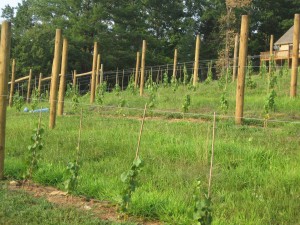
A view of our vineyard
We decided a year ago, after planting a small, educational vineyard (i.e., seven vines, planted for the sole purpose of getting some hands-on experience with viticulture) to forego the use of grow tubes. That was a tough choice. Almost every vineyard we’ve visited nurtures young vines in grow tubes, and there’s probably good reason to use them in large commercial undertakings.
But we decided against them for our small hobby vineyard for reasons that we think make sense. Most of the research we’ve looked at suggests that vines raised without grow tubes do better in the long run than those that spend their formative months inside protective shelters. We happened to speak to a vintner from South Africa over the weekend, and he echoed our views, noting that he had not even seen a grow tube before arriving in the United States. He still believes, he said, that the vines are better off without them.
But, of course, everything comes with a price. And this weekend, we got a real taste of the price you pay for growing vines without protective shelters.
The main reason vineyards love grow tubes is because it makes cultivation easy. You can spray herbicides such as Round Up around the vine to kill off the weeds without having to worry that your Cab Franc will die with them. Okay, I know that’s not a controversy-free statement. Advocates of organic wine, natural wine, biodynamic farming and so on will object right off the bat to the use of herbicides, however easy they make the task of maintaining a vineyard. And my heart is mostly with them, for a variety of reasons I’ll explore in future posts. But the fact is, keeping the weeds down without Round Up can be just plain drudgery.
Trust me, I have the aching muscles to prove it.
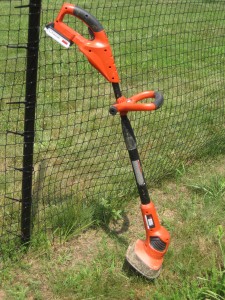
Our battery-powered cultivator, standing tall and proud
Now, it’s true that our vineyard is small. Right now we have only 150 vines, and the space they take up wouldn’t fill a small corner of even the smallest of the Commonwealth’s commercial vineyards. So we thought we could afford a few luxuries when it came to maintaining the vineyard. But it turns out that pulling weeds by hand is work – really, really, really hard work.
We started off a few weeks ago with nothing more than a hoe and our own hands. And by “we,” I mean my wife, the Vineyard Goddess, as I was still recovering from surgery on my cervical spine (Level 4 ACDF for those of you who know or care about these things). I was there in spirit, but it was the Vineyard Goddess who was working the soil with a hoe, and then kneeling down to pull the weeds by hand. I wasn’t actually there, but I have no doubt that it was slow, painful work.
And I know that, because we talked about it. I might have been unable to do physical labor, but I was still available as a consultant, and it occurred to me that there might be mechanical devices to help with this chore. Sure enough, there are. My preference would have been a small, gas-powered cultivator, but with our very steep slopes, we were concerned that we wouldn’t be able to control it well enough to avoid damage to the vines.
We looked at the somewhat smaller electrical tillers, both corded and battery-powered, and settled on the latter. The corded ones are probably perfect for a garden located next to the house, but our vineyard is a significant hike from the house. And the furthest rows are, as they say, “a fur piece.” Continue Reading–>
Spring in the Vineyard
Cab Franc vines, still protected by mounds of dirt, showing exuberant growth before being un-hilled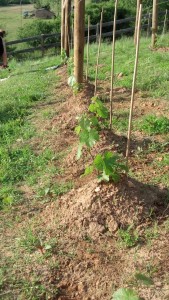
Despite months of crazy weather, it's finally springtime in the vineyard. And after all the hours of planning and research and all the work that went into getting the vineyard ready for planting vines – not to mention the planting itself – I was pretty bummed about not getting to see the early fruits of our labor this weekend. My wife, Chris, ably assisted by daughter Kate, the vineyard volunteer worker, traveled to Afton without me this weekend to un-hill new vines, continue the work on the deer fence, and handle a dozen other tasks that demand attention in the spring.
So, this isn’t exactly an eyes-on report from the scene. It’s more like something cobbled together by an editor hunkered down in a newsroom, piecing together a story out of dispatches sent in by reporters from the front lines. I've been both a reporter and an editor in my life, and believe me, being a reporter is way more fun. Editors sit behind desks in newsrooms waiting for reporters to tell them what’s going on. When I was an editor, I generally got cranky while waiting. Reporters get out of the office and see things happen. Even in the day of Blackberries and instant communication, I'm sure they still keep editors at bay during the day by telling them there’s way too much going on to stop and talk. And they’re usually right.
Petit Verdot vines after removal of the earth mounds, or hills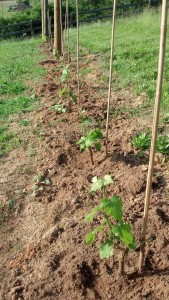
In this case, Chris and Kate filed their dispatches by text messages, emailed pictures, and a number of old-fashioned cell-phone calls, all of which provided some color on the early progress our vines are making. I have to say, we’re just thrilled with the results. Out of the 150 vines we planted this spring, only one appears to be clearly dead, according to the reports I've received, although another ten are doubtful. But the rest look magnificent! (Especially in the pictures.)
I’m particularly pleased with the progress of the first group of Cabernet Franc vines that we transplanted from our Fairfax vineyard two weeks ago. They not only survived, but they’re flourishing. And they have fruit! Big clusters of berries that will turn into grapes very soon if we leave them on the vine. Which, of course, we won’t. Even if the vines hadn’t been through the shock of being dug up in Fairfax and replanted in Afton, they’re still only in their second year of life, and they needto devote all of their energy to developing a strong root system and trunk. So we’ll be dropping the fruit soon.
Clusters of berries that would eventually be Cab Franc wine grapes if we let them continue to mature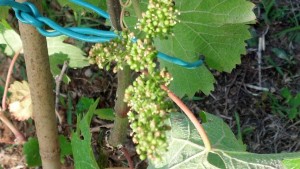
We had planted seven Cab Franc vines in Fairfax a year ago, all for the purpose of getting additional hands-on experience working with vines. This weekend, Chris dug up the last three and moved them, so the Fairfax “vineyard” is officially defunct, although it lives on in spirit in Nelson County. We can’t be sure that all seven will make it, but we’re very hopeful.
Cab Franc vines still in transplant shock from being moved on May 19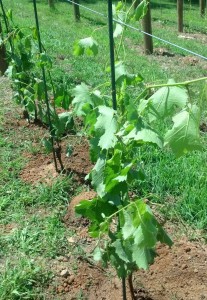
In any event, I'm glad we tried this experiment, which was prompted by an article by WineMaker’s magazine’s Wes Hagen. He recommended ordering extra vines and planting the excess closely together on some spare land. That way, you have some surplus vines to replace the ones that inevitably will die. And that’s one of the sad facts of viticulture. No matter how good you are, no matter how carefully you plant, and no matter how great the nursery you buy from, you’re going to lose some plants. So, even though some of the 50 Cab Franc vines that we planted this year will surely die, with the additional one-year old vines Fairfax we should end up ahead of the game. Wish I had read the Wes Hagen advice before we ordered vines for planting this year.
Looking at the rest of the vinyeard, our whites are doing quite well. We planted 25 each of Petit Manseng and Viognier on the weekend of March 31, and mounded hills of earth over them, covering the graft union with about two inches of soil to protect the dormant vines from the possibility of late frost. We un-hilled them two weekends ago on May 6, and they have been doing quite well ever since.
Close up of a Petit Manseng vine that was planted April 21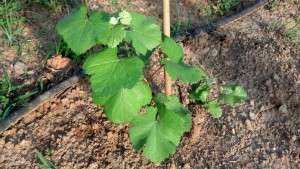
Likewise, the reds are showing great promise. Chris and Kate un-hilled the 100 Cab Franc and Petit Verdot vines that we planted over three days in early April. Both grapes seem to do well in Virginia, and we are wildly optimistic about their potential. Which, of course, puts us in the company of farmers everywhere who start each spring full of optimism, no matter how bad the previous year went. And don’t get anyone started talking about the 2011 vintage. Trust me, just don’t.
A row of Viognier vines - all healthy so far!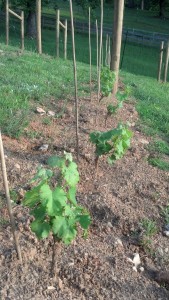
By the way, the un-hilling I did two weeks ago involved a lot of careful work with my hands, but it was positively crude compared to Chris’s method. I pushed the dirt aside a little bit at a time, until the vine was completely uncovered. Okay, maybe a spare bud or two got knocked off in the process.
Chris would have none of that. She bought a makeup brush for the final removal of soil from the vines, and claims it worked like a charm. I wasn’t there, so I’ll take her word for it. It seems like a pretty time-consuming approach, so I’m pretty confident that I’ll do my part of the un-hilling next year sans the makeup brush. Unless of course the vines she un-hilled do better than mine. Let’s not even go there, okay?
And there’s still so much work to be done. I think I’m recovering well enough from surgery that I’ll be able to be in Afton myself for the next trip. Chris and Kate have gotten to be quite the dedicated and skilled vineyard workers, handling everything from driving posts into the ground to planting vines. I’d sure like to be able to lend a hand. Or at least be there to watch with great enthusiasm while they do the work
An Hour of Frost
Well, it doesn’t take much. The forecast called for temperatures in my part of Fairfax County to dip below freezing for less than two hours, but that was enough to do some damage. At least one of the vines appears to have sailed through the night with flying colors, but the others experienced at least some degree of frost damage. As noted in my
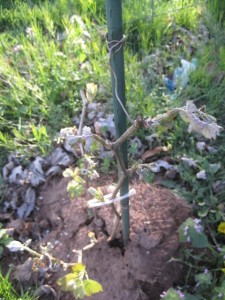
- Some damage on this vine – it’s hard to see in this picture, but compare the shriveled leaves on the right with the green, healthy ones on the left side.
previous post, this is a critical time of the year for vines. Late frost is a threat in any year, but the early bud break this spring left vines everywhere in the state exposed to the threat of frost in the weeks ahead.
As WineMaker magazine noted, late frost is a danger “because the first green growth produced on a new grapevine shoot is two or three basal leaves, immediately followed by the embryonic flower clusters that will become this year’s crop. So, if frost strikes, it can greatly reduce or even wipe out the whole vintage.”
For my vines in Fairfax, I believe the danger is even more acute because they are still small and the buds are so close to the ground, where the temperature is coldest. We’re still new at this, and it’s possible we pruned them back too far over the winter. For the vines we plant this spring, we’ll definitely be focused on strategies for dealing with late frost, and I’ll talk about some of them in an upcoming post.
Of course, one of the most important considerations in dealing with frost is site selection, and we’ve already cast that particular die. The Fairfax vineyard is challenged on at least two counts. It’s at a low elevation, and it’s on flat ground, so the cold air has no place to go. In Nelson County, where we have some vines planted and are preparing to plant another 150, the elevation is higher, around 750 feet, but not high enough to put us in the atmospheric sweet spot that probably runs from about 800 to 1,600 feet above sea level. On the other hand, the land is sloped, so the heavier cold air should flow down hill and off the vineyard. We’ll see.
But no matter how well you plan, you may still find yourself dealing with late frost. I suspect most commercial vineyards in the state were monitoring the vines throughout the night and taking steps to mitigate the frost threat. Larger vineyards have a number of tools they can bring to bear, including wind machines, heaters, and helicopters. Many vineyards gather the wood pruned from the vines over the winter and leave it at the end of the rows to burn on nights where frost threatens.
This year, we didn’t have a lot of choices beyond praying and hoping. However, the Fairfax vineyard is only experimental; I’m not expecting to ever make wine from those grapes, although it would be a definite bonus if I do. But for the vines we are putting in the ground this Spring, we’ll probably have some sleepless spring nights in our future.
The Perils of an Early Spring
We arrived home Sunday afternoon to find that the vines in our Fairfax vineyard were blooming in a magnificent way. I had pruned them during the winter, when they were still dormant, and have been wondering ever since if I had cut cut them back too severely. When I saw them on Sunday, though, I felt vindicated. Yes! Yes ! They would be up to the first wire (30 ” – or maybe 36″, I actually haven’t put the trellis in yet) in no time flat, I assumed.
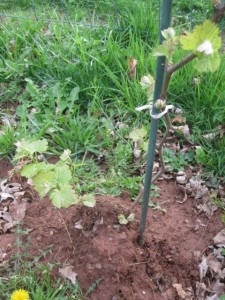
The Fairfax vineyard is a bit overrun with weeds right now, but you can see the leaves on this vine if you look closely.
I couldn’t have been happier. Until I showed the vines to my wife, the Vineyard Goddess.
“Well, that’s good and bad,” she said. Good, of course, because the vines looked so healthy and productive. But mostly bad, because, it’s still March and we could have some frost ahead of us. The bud break I observed on my vines had come very early in the season. And when she glanced over my shoulder at this post, she added another rule of thumb for vineyard management: “March will always be too early for bud break.”
And of course she was right. (She’s pretty much always right. Thank God she’s watching over our vineyard.) This evening, I found an email alert from Tony Wolf, the Virginia Tech viticulture specialist, and probably the state’s foremost expert on all things viticultural, warning of the likelihood of freezing temperature overnight. According to NOAA ‘s web site, temperatures will drop to about 31 degrees tonight in Afton, the site of our Nelson County vineyard, and 30 degrees in Fairfax, where the aforementioned vines are Continue Reading–>

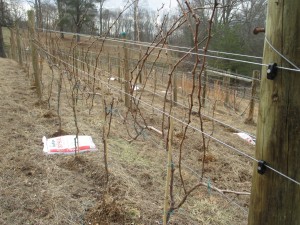
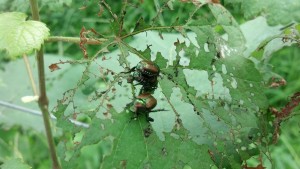
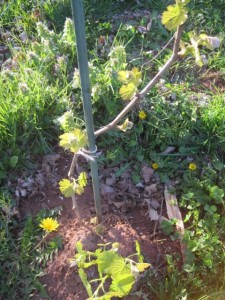


Recent Comments